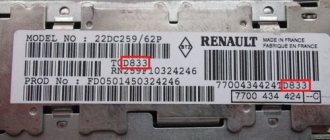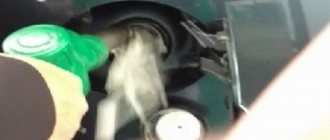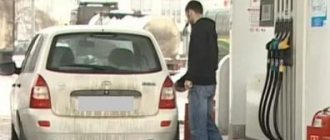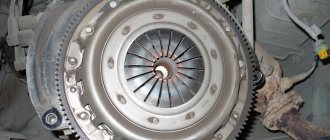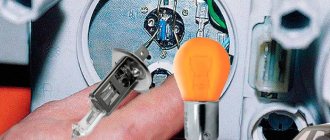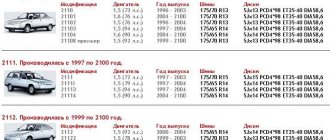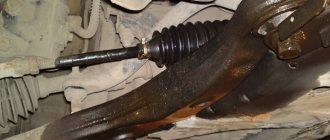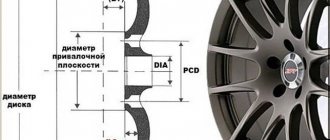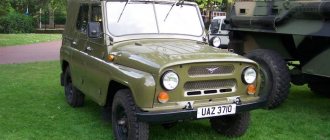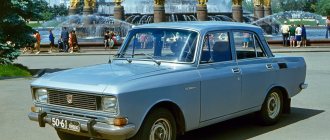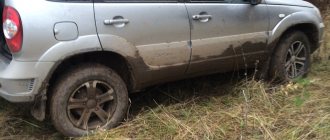The loosening of wheel rims can easily be attributed to minor car tuning. For many car enthusiasts, changing the appearance of their “iron horse”, giving it exclusivity, and making it recognizable in the stream of other vehicles is a real dream.
But, as a rule, there is not enough money for serious changes, but installing new disks is a simple and quite affordable type of tuning.
But there is one problem - beginners lose sight of the wheel bolt pattern.
What it is?
Almost every make (model) of car has its own wheel bolt pattern. To designate the parameter, the abbreviation PCD is used, next to which numerical designations are indicated.
In simple words, the bolt pattern is the diameter along which the holes are made for attaching the wheel.
As a rule, car enthusiasts do not pay attention to this parameter and often install wheels with an inappropriate bolt pattern.
As a result, the wheel becomes incorrect. It is difficult to visually identify the problem, but the consequences can be very dire.
Disc labeling
When choosing a disk, you should take into account not only its bolt pattern, but also a number of other key parameters.
Let's say you have a disk with parameters in front of you - 6.5Jx15 H2 5x100 ET45 d54.1
. For an inexperienced car enthusiast, this is a common set of numbers. In fact, here is complete information about the product:
- 6.5 is the width (W), measured in inches (and not centimeters, as many people think);
- 15 is the diameter (D). Here the unit of measurement is also inch;
- 5*100 is a designation that indicates the number of landing bolts (5) and diameter (100).
Another example.
It is the diameter that interests us most (this is the PCD parameter that we mentioned above).
PCD size is given in millimeters:
- ET45 is a parameter by which you can judge the disc offset. Essentially, this is the distance between the plane that is pressed against the hub and the axis of symmetry of the product. ET45 means an overhang of 45 mm.
- d54.1 – indicates the diameter of the central hole (DIA, measured in millimeters). It has become fashionable among many manufacturers to overestimate this parameter.
In the future, special rings are used that eliminate vibration.
Regarding the digital designations “ J
" and "
H2
", they are used only by specialists.
The first parameter provides information about the design features of the side edges, and the second is a symbol for the annular protrusions on the rim (humps).
Wheel rim bolt pattern on Lada
Bolt pattern is a calculated characteristic of wheels, which determines the number of mounting holes and the diameter of their location circle. This characteristic is the same for almost all AvtoVAZ models and depends on the following vehicle indicators:
Wheels for VAZ 1111
- The weight of the car in running order, that is, fully equipped, with passengers and the maximum possible weight of cargo in the trunk.
- The nature of the vehicle’s operation, namely how important overloads are for a given vehicle. If we are talking about a city sedan, then a bolt pattern of 4 studs is quite enough for it, but a crossover or SUV is certainly equipped with 5 or 6 threaded rods, because off-road driving can temporarily increase the load on the wheel several times.
- Dynamic properties of the car. When entering a turn at high speed, as well as getting into holes, the impact increases the load on the hub studs exponentially.
Important!
Automotive plant engineers prescribe the bolt pattern depending on the maximum load on the vehicle with the required safety factor.
Wheels for model 2104
Fit Features
The wheel rim bolt pattern must comply with the manufacturer's recommendations. What to do if your car has PCD 100*4
, but did you really like the disc with
PCD 98*4
? Experts recommend refusing such a purchase.
But why, is it impossible to visually determine the difference? The discrepancy will definitely show itself.
After one of the bolts is fully tightened, the remaining holes move slightly to the side.
Of course, the bolts can be tightened somehow, but due to incomplete fit on the hub, you can’t dream of a high-quality tightening (we’ll look at some solutions to the situation below).
Remember that mounting a disk with different bolt patterns is dangerous. At first a slight beating appears. It may seem insignificant, but over time it leads to the destruction of the steering mechanism and vehicle suspension.
It can be even worse - due to poor-quality broaching, the wheel unscrews while driving and then an accident cannot be avoided.
Bearings VAZ - 2101, 2102
A little information. VAZ-2101 “Zhiguli” is a Soviet rear-wheel drive passenger car with a sedan body. On the basis of the VAZ-2101, the so-called “classic” family of VAZ cars was created, which was on the assembly line until September 17, 2012. For the release of this model in May 1972, the Volzhsky Automobile Plant was awarded the International Golden Mercury Award. In 2000, the VAZ-2101 was named the best domestic car of the 20th century according to the results of an all-Russian survey conducted by the magazine “Behind the Wheel”. Over the entire period of production (from 1970 to 1988), the Volzhsky Automobile Plant produced 4.85 million VAZ-2101 cars of all modifications with a sedan body.
Refill containers.
— fuel tank — 39 l
— engine cooling system with body heating system 9.6 l (Antifreeze A-40)
— 3.75l engine lubrication system
— gearbox housing 1.35l (TAD-17I)
— drive axle housing 1.3 l (TAD-17I)
— steering gear housing 0.215l (TAD-17I)
Table of applicability of bearings VAZ - 2101, 2102
| Installation location | Number | Bearing type | Size | Qty |
| Cardan shaft (support) | 180505 | Ball radial single row | 25x52x18 | 1 |
| Cardan shaft (crosspieces) | 904902 | Needle radial single row without inner ring and separator | 14.7x23.8x13.1 | 8 |
| Generator | 180201 | Ball radial single row | 12x32x10 | 1 |
| Generator | 180302 | Ball radial single row | 15x42x13 | 1 |
| Jack | 8903 | Ball thrust single | 17.5x30x8.9 | 1 |
| Gearbox (secondary shaft) | 205 | Ball radial single row | 25x52x15 | 1 |
| Gearbox (secondary shaft) | 50306 | Radial single-row ball with a locking groove on the outer ring | 30x72x19 | 1 |
| Gearbox (secondary shaft) | 464904 | Needle single row without rings | 19.3x25.3x19.8 | 1 |
| Gearbox (primary shaft) | 50706 | Radial single-row ball with a locking groove on the outer ring | 30x75x19 | 1 |
| Gearbox (primary shaft) | 180502 | Ball radial single row | 15x35x14 | 1 |
| Gearbox (intermediate shaft) | 92705 | Roller radial with flat thrust ring | 25x55x18 | 1 |
| Gearbox (intermediate shaft) | 156704 | Double row angular contact ball | 20x50x20.6 | 1 |
| Rear axle | 7705 | Roller conical single row | 28x67x20 | 1 |
| Rear axle | 7707 | Roller conical single row | 33x62x16 | 2 |
| Rear axle | 7807 | Roller conical single row | 34.9x73.0x26.9 | 1 |
| Rear axle | 180306 | Ball radial single row | 30x72x19 | 2 |
| Water pump | 330902 | Double-row radial ball with a roller instead of an inner ring | 16x30x115 | 1 |
| Distributor | 7690906 | Ball radial single row | 30x47x7/8 | 1 |
| Steering | 836904 | Single row angular contact ball with stamped rings | 20.5x36.3x39 | 2 |
| Steering (crosspieces) | 904900 | Needle radial single row without inner ring and separator | 10x16x10.5 | 8 |
| Steering | 996805 | Ball thrust single without one ring | 28x50x20.2 | 1 |
| Steering | 996905 | Ball thrust single without one ring | 28x47x13.2 | 1 |
| Front wheel hubs | 7804 | Roller conical single row | 19.1x45.3x15.5 | 2 |
| Front wheel hubs | 7805 | Roller conical single row | 26x57.2x17.5 | 2 |
| Clutch | 360708 | Ball radial single row | 40x70x18 | 1 |
See also:
- Bearings Moskvich 400-420.
- Bearings Moskvich-2141.
- Bearings ZAZ 965A “Humpbacked Cossack”
- Bearings VAZ-2112.
- Bearings Gas-21
- Bearings VAZ 2110 “Ten”
- Bearings Izh-Jupiter, Jupiter 2, Jupiter 3, Jupiter 5.
- Bearings VAZ 2105 LADA
- Bearings MAZ-503A
Features of the VAZ
Many car enthusiasts are interested in the question of what wheel bolt pattern is on domestic VAZ cars.
Here PCD is standard - 4*98. But such a bolt pattern has one big disadvantage - there is no room for flight of fancy and the possibility of choosing a more unique disc.
At the same time, “next door” there is a PCD standard - 4*100, where the choice of disks is much wider. So is it possible to take a risk with a replacement? As we have already mentioned, with standard tightening methods this is unacceptable, because even a small error will not allow the screws to be properly tightened.
There are car enthusiasts who take certain risks. They use longer screws or do not tighten one of them at all. But this is dangerous - such methods can lead to serious consequences (including road accidents).
But there is a way out.
To install 4*100 wheels on VAZ cars, you can use special bolts with an offset center or an eccentric (they are easy to find in car stores or on the Internet).
In addition, studs from the VAZ 2108 cylinder head type are often used.
The peculiarity of the installation is that the studs are screwed directly into the hub, and the disc is tightened with the help of other nuts (you can “borrow” it from Niva).
Another option is to bore a hole in the hub. In this case, it will be possible to install disks with different PCD bolt patterns - 4*100 or 4*98.
Eight-hub classic
The adapter is designed for installing a maintenance-free VAZ 2108 hub on the front axle of VAZ “Classic” cars.
The transition of the front hub of the VAZ 2101-2107 to the VAZ 2108 allows you to increase the reliability of the hub assembly.
By replacing two angular contact roller bearings with one double-row angular contact ball bearing, we eliminate the need to adjust the clearance in the bearings. In addition, the VAZ 2108 bearing is designed for higher loads and is more durable (I do not take into account products from underground manufacturers)
It was decided not to deprive the car of the ability to move by disassembling the original steering knuckles, but to assemble everything new. In this regard, a completely new set was purchased, consisting of the knuckles themselves, steering bipods and a set of fasteners (bolts with groovers and nuts, locking plates), in addition, I purchased IZH-Oda hubs, SKF eight-wheel wheel bearings, retaining rings and thrust washers from same, as well as classic thrust washers and hub nuts. Unfortunately, I don’t remember the exact prices. Too much time passed from the moment of purchase to installation... In addition, as a sample, I purchased a steering knuckle from Oda. Figure 1 shows classic and Odov fists for comparison.
I won’t give details here of how I did it all and then redid it... But I ruined one set of faceplates... The main thing is the end result. So, Figure 2 shows a sketch of the modernized hub assembly.
Now let's start remaking the fist itself, sketch in Figure 3.
Figure 4 shows a simplified route technical process for regrinding a fist. Well, I can’t live without technology – that’s what my profession is like.
By regrinding... We base it on alignments in the centers. First of all, we form the fits for the bushings. Diameter 26 is simply dusted to obtain alignment, and diameter 21 is sharpened as close as possible to the nominal size. Because Everything is done individually, then we sharpen our own bushing for each fist. We measure the actual size of the fits and sharpen the bushings with a tightness of 6-8 hundred parts. When working on a lathe with a bore gauge, it’s quite possible to catch a couple of hundred. I say this as a person who has experience working on a lathe. When pressing the bushings, they must be heated to a crimson color, approximately 500°C. I did this in a forge. After this heating, the bushings should sit freely.
Next you need to grind the bearing seat. Finding the diametrical size is not difficult for a normal grinder, but maintaining a linear size of 26.5 mm is not realistic... It is impossible to make a groove on the bushing for the exit of the grinding wheel, so as not to create a stress concentrator, but it is necessary to touch the end for the bearing to rest. Therefore, after grinding, we measure the actual size from the end of the bearing stop collar to the mating plane of the faceplate (size 26.5).
Next, lathe again... After the fist is ready, it is advisable to make a center hole at the end, so that if it is necessary to press out the hub, there is somewhere for the puller to rest. Maintaining alignment is not necessary, and it is not realistic.
The fist is ready. Now we need to modify the hub. From the bearing landing side we trim it by 3.5mm. Otherwise, during assembly, the hub will rest against the heads of the bolts that secure the faceplate and steering bipod.
Now you need to measure everything again and calculate the dimensional chain. The caliper should be clearly in the axis of the brake disc. To do this, it is necessary to catch a size of 13 mm from the end of the thrust flange of the bearing to the mating plane of the caliper. In other words, we need to calculate the thickness of the faceplate. We measured the actual size (in the sketch it is size 26.5). For me it turned out to be 26.7mm (Figure 2). Subtract 13 mm from it (caliper position). Now let’s figure out what kind of boot it will be. I made it from a stamped aluminum pan with a diameter of 280mm. Because the boot is aluminum, then in order to avoid crushing the metal by the bolt heads, and, as a result, loosening of the connection, I placed the boot between the PF (faceplate) and the fist (Figure 2). If you install the boot like I did, it will participate in the calculation of the dimensional chain. If the boot is steel (standard modified or simply from a steel vessel), then it can be placed on the FS and then it does not participate in the calculation.
